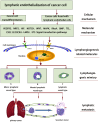Mechanisms of Cancer Cell Lymphatic Endothelialization in Tumor Lymphangiogenesis and Metastasis: A Comprehensive Review
- PMID: 40809467
- PMCID: PMC12345934
- DOI: 10.2147/JIR.S535351
Mechanisms of Cancer Cell Lymphatic Endothelialization in Tumor Lymphangiogenesis and Metastasis: A Comprehensive Review
Abstract
Cancer cell lymphatic endothelialization refers to the transformation of cancer cells into lymphatic endothelial cells through complex cellular and molecular mechanisms, which involve transdifferentiation of cancer cells and their fusion with endothelial cells, both modulated by multiple signaling pathways. This process reflects a dual phenotype comprising features of both cancer cells and lymphatic endothelial cells. The expression of lymphatic-specific markers, including PDPN, LYVE1, PROX1, and SOX18, serves as molecular evidence of this process. Histopathologically, this phenomenon is manifested through lymphangiogenic mimicry, which can be classified into lymphatic-like, mosaic, and lymphatic types. This study presented a theoretical framework to elucidate the developmental mechanisms driving cancer cell lymphatic endothelialization and provided a new theoretical basis for understanding the cellular origin of tumor-associated neolymphatic vasculature and introduces new pathways for investigating mechanisms of tumor lymphangiogenesis and metastasis, thereby providing potential avenues for clinical treatment strategies.
Keywords: cancer cell lymphatic endothelialization; lymphangiogenesis molecules; lymphangiogenic mimicry; tumor lymphangiogenesis; tumor lymphatic metastasis.
© 2025 Wang et al.
Conflict of interest statement
The authors declare that they have no competing interests.
Figures

Similar articles
-
Prescription of Controlled Substances: Benefits and Risks.2025 Jul 6. In: StatPearls [Internet]. Treasure Island (FL): StatPearls Publishing; 2025 Jan–. 2025 Jul 6. In: StatPearls [Internet]. Treasure Island (FL): StatPearls Publishing; 2025 Jan–. PMID: 30726003 Free Books & Documents.
-
Short-Term Memory Impairment.2024 Jun 8. In: StatPearls [Internet]. Treasure Island (FL): StatPearls Publishing; 2025 Jan–. 2024 Jun 8. In: StatPearls [Internet]. Treasure Island (FL): StatPearls Publishing; 2025 Jan–. PMID: 31424720 Free Books & Documents.
-
Electrophoresis.2025 Jul 14. In: StatPearls [Internet]. Treasure Island (FL): StatPearls Publishing; 2025 Jan–. 2025 Jul 14. In: StatPearls [Internet]. Treasure Island (FL): StatPearls Publishing; 2025 Jan–. PMID: 36251838 Free Books & Documents.
-
The prognostic influence of lymphatic endothelium-specific hyaluronan receptor 1 in cancer: A systematic review.Cancer Sci. 2022 Jan;113(1):17-27. doi: 10.1111/cas.15199. Epub 2021 Nov 24. Cancer Sci. 2022. PMID: 34775672 Free PMC article.
-
Toward Characterizing Lymphatic Vasculature in the Mammary Gland During Normal Development and Tumor-Associated Remodeling.J Mammary Gland Biol Neoplasia. 2024 Jan 13;29(1):1. doi: 10.1007/s10911-023-09554-w. J Mammary Gland Biol Neoplasia. 2024. PMID: 38218743 Free PMC article. Review.
References
Publication types
LinkOut - more resources
Full Text Sources
Miscellaneous

